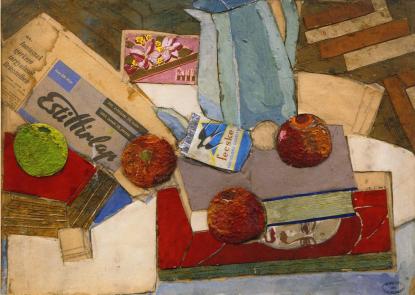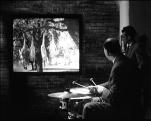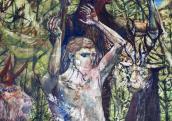2024. November 22. Friday
New Budapest Gallery - Budapest
|
|
Address: 1056, Budapest Bálna-Budapest, Fővám tér 11-12.
Phone number: (1) 426-4714
E-mail: info@budapestgaleria.hu
Opening hours: Tue-Sun 10-18
|
The exhibition has closed for visitors.
2016.06.08. - 2016.09.18.
Museum tickets, service costs:
|
Ticket for adults
|
1000 HUF
|
/ capita
|
|
Ticket for students
|
500 HUF
|
/ capita
|
|
Ticket for pensioners
|
500 HUF
|
/ capita
|
Blow-Ups centres around one particular year in the Sixties: 1963. It does this through the lens of a single work, Miklós Jancsó’s film Cantata, which was shot in 1962 and released in early 1963. In the film, the main protagonist, Ambrus Járom (played by Zoltán Latinovits), meanders around Budapest, strolling from one meeting place for intellectuals to another. He eavesdrops on seemingly endless debates in cafés, or, during a gathering in a studio apartment, watches an experimental film that was made with his participation. The series of scenes, which begins in the EMKE building and ends in the apartment of Járom’s physician colleague, offers a vivid portrayal of the intellectual milieu, with all its dilemmas, in which the Hungarian intelligentsia found itself at the time. The focus on individual scenes, locations, objects and subjects raised in the film allows the outlines of the tensions among and faced by the intellectuals of the era to emerge.

The exhibition examines numerous areas of culture. Proceeding from the concepts and relations of the visual arts, it endeavours to reinterpret questions pertaining to culture, art and society in Hungary from the perspective of today. It investigates official art and alternative culture and their parallel existence. The exhibition, which has been divided into several sections, focuses on different aspects of the film. It highlights certain objects, works of art, and documents, and it outlines the context necessary for a nuanced understanding of the era.
The individual sections focus in particular on the art of Lili Ország, János Orosz, Ákos Szabó, and Béla Gruber, as well as on painting in the early 1960s, posters by Gábor Papp, the architecture of the period and the city of Budapest at the time, and the gatherings which took place in private apartments (the saloons of Dr László Végh and Pál Petrigalla), also devoting attention to the furnishings of contemporary apartments. Furthermore, the exhibition will conjure the spirit of legendary figures, such as Béla Kondor, János Pilinszky and Miklós Erdély.
Principal lending and collaborative partner: Municipal Gallery – Kiscell Museum.
We would like to express our gratitude to the Gruber Family, private collectors of works by Béla Gruber, the Museum of Applied Arts, the Hungarian Jewish Museum and Archives, the Janus Pannonius Museum of Pécs, and the Rómer Flóris Museum of Art and History in Győr for lending works of art from their collections.

The exhibition examines numerous areas of culture. Proceeding from the concepts and relations of the visual arts, it endeavours to reinterpret questions pertaining to culture, art and society in Hungary from the perspective of today. It investigates official art and alternative culture and their parallel existence. The exhibition, which has been divided into several sections, focuses on different aspects of the film. It highlights certain objects, works of art, and documents, and it outlines the context necessary for a nuanced understanding of the era.
The individual sections focus in particular on the art of Lili Ország, János Orosz, Ákos Szabó, and Béla Gruber, as well as on painting in the early 1960s, posters by Gábor Papp, the architecture of the period and the city of Budapest at the time, and the gatherings which took place in private apartments (the saloons of Dr László Végh and Pál Petrigalla), also devoting attention to the furnishings of contemporary apartments. Furthermore, the exhibition will conjure the spirit of legendary figures, such as Béla Kondor, János Pilinszky and Miklós Erdély.
Principal lending and collaborative partner: Municipal Gallery – Kiscell Museum.
We would like to express our gratitude to the Gruber Family, private collectors of works by Béla Gruber, the Museum of Applied Arts, the Hungarian Jewish Museum and Archives, the Janus Pannonius Museum of Pécs, and the Rómer Flóris Museum of Art and History in Győr for lending works of art from their collections.


